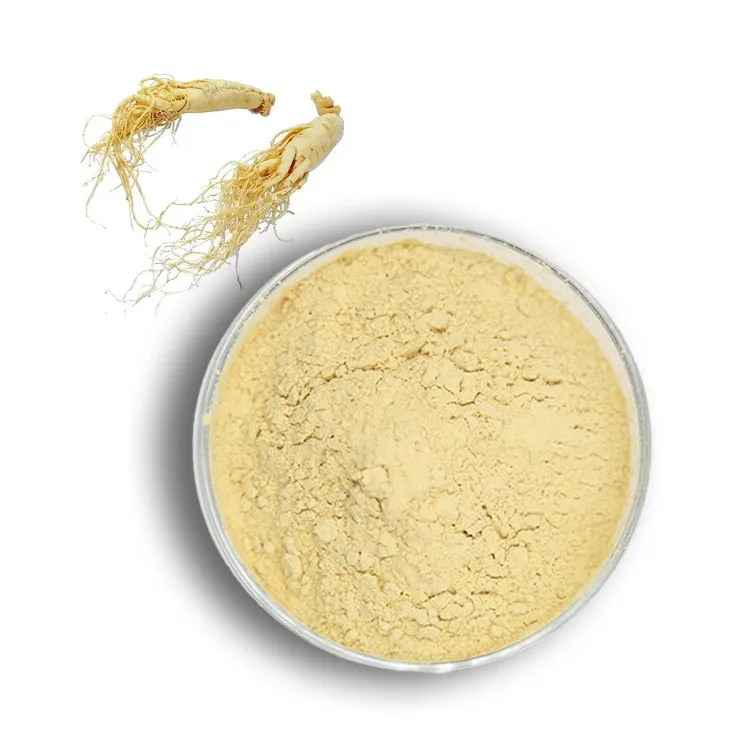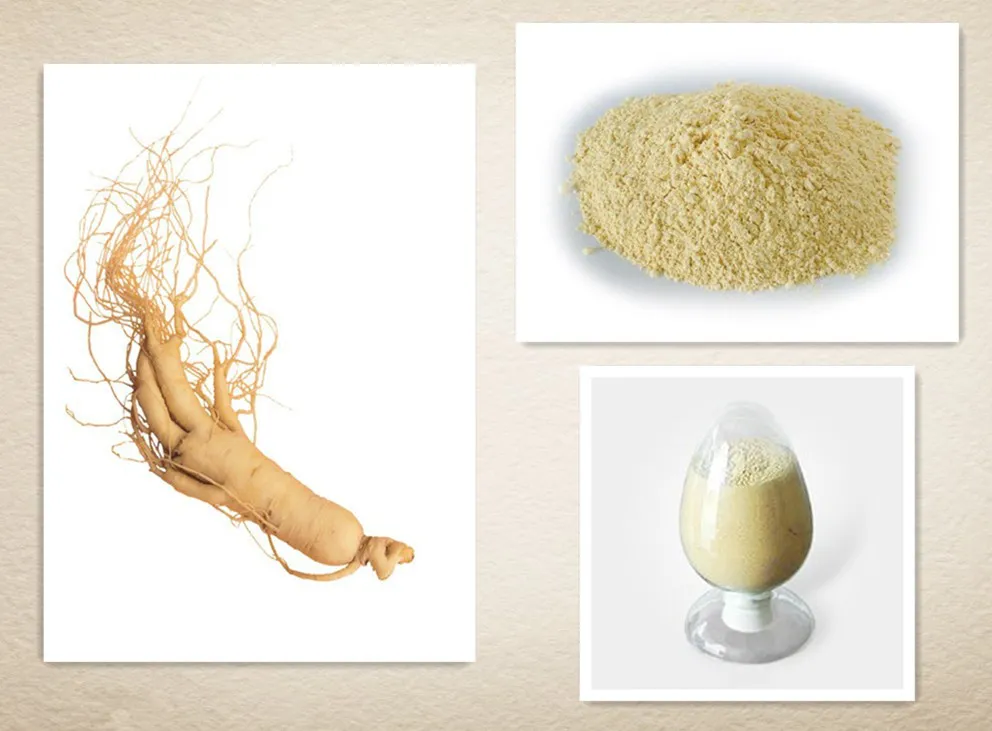- 0086-571-85302990
- sales@greenskybio.com
Ginseng Root Extract: Uses, Advantages and Manufacturing Processes
2024-11-12

1. Introduction
Ginseng, a well - known plant in traditional medicine systems around the world, has been used for centuries for its various health - promoting properties. Ginseng Root Extract is a concentrated form of the beneficial components present in the ginseng root. It has gained significant popularity in recent years due to its wide range of potential applications in different industries, especially in the food and herbal medicine sectors.

2. Uses of Ginseng Root Extract
2.1 In the Food Industry
In the modern food industry, consumers are increasingly interested in products that offer not only taste but also health benefits. Ginseng Root Extract serves as an excellent functional ingredient in this regard. It is often added to dietary supplements and health foods.
- Many energy bars and drinks contain ginseng root extract as it is believed to provide a natural energy boost. This can be particularly appealing to those who are looking for an alternative to caffeinated products.
- Some fortified breakfast cereals also include ginseng root extract. These products target consumers who are conscious about their overall well - being and are willing to incorporate natural health - promoting ingredients into their daily diet.
2.2 In Herbal Medicine
Ginseng has a long and rich history in herbal medicine. The root extract is highly regarded for its adaptogenic qualities.
- It is used to help the body adapt to various stressors. Whether it is physical stress from overexertion or mental stress from a high - pressure job, ginseng root extract may play a role in modulating the body's response.
- In traditional medicine systems like Traditional Chinese Medicine (TCM) and Ayurveda, ginseng root extract has been used to treat a variety of ailments. For example, it may be used to improve digestion, enhance mental clarity, and promote longevity.

3. Advantages of Ginseng Root Extract
3.1 Stress Modulation
One of the key advantages of ginseng root extract is its ability to modulate the body's response to stress. Stress is a common factor in modern life, and chronic stress can have a negative impact on overall health.
- When the body is exposed to stress, it activates the stress response system, which releases hormones like cortisol. Ginseng root extract may help regulate this hormonal response, preventing excessive cortisol release. This can lead to a more balanced state in the body, reducing the negative effects of stress on the body and mind.
- By improving the body's resilience to stress, ginseng root extract can also enhance physical and mental performance. Athletes and individuals with high - stress jobs may benefit from this property, as it can help them perform better under pressure.
3.2 Anti - Inflammatory Effects
Another significant advantage of ginseng root extract is its potential anti - inflammatory effects.
- Inflammation is a natural response of the body to injury or infection. However, chronic inflammation has been linked to many diseases, such as heart disease, diabetes, and certain types of cancer. Ginseng root extract may help reduce chronic inflammation in the body.
- It contains bioactive compounds that can interact with the body's immune system and inflammatory pathways. For example, some studies have shown that ginseng root extract can inhibit the production of pro - inflammatory cytokines, which are molecules involved in the inflammatory response.
3.3 Overall Well - being Promotion
Ginseng root extract also has the potential to promote overall well - being.
- It may improve cardiovascular health. Some research suggests that it can help regulate blood pressure and cholesterol levels. By doing so, it can reduce the risk of developing heart - related diseases.
- For the immune system, ginseng root extract can act as an immunomodulator. It can enhance the function of the immune cells, making the body more resistant to infections.
- On the cognitive front, it may improve memory and concentration. This is especially important in an aging population, where cognitive decline can be a significant concern.

4. Manufacturing Processes of Ginseng Root Extract
4.1 Raw Material Preparation
The manufacturing process of ginseng root extract begins with the careful selection and collection of fresh ginseng roots.
- First, the ginseng roots are harvested at the appropriate time. The timing of the harvest can affect the quality and potency of the extract. Ginseng roots are typically harvested when they have reached a certain level of maturity, which can vary depending on the type of ginseng.
- After harvesting, the roots are thoroughly cleaned. Any dirt, debris, or other impurities are removed. This is a crucial step as it ensures the purity of the final extract.
- The cleaned roots can then be either processed immediately or stored for later extraction. If stored, proper storage conditions need to be maintained to preserve the quality of the roots. This may involve storing them in a cool, dry place or using specific storage techniques to prevent spoilage.
4.2 Extraction Methods
There are several methods used for the extraction of ginseng root extract, with two common ones being heat reflux extraction and enzymatic extraction.
4.2.1 Heat Reflux Extraction
- In heat reflux extraction, the cleaned ginseng roots are placed in a suitable solvent, such as ethanol or water. The solvent is chosen based on its ability to dissolve the desired components from the ginseng roots.
- The mixture is then heated to a specific temperature. The heat causes the solvent to reflux, which means it continuously circulates between the heating source and the extraction vessel. This helps in more efficient extraction of the bioactive compounds from the ginseng roots.
- The extraction process typically lasts for a certain period, which can range from a few hours to several days, depending on the nature of the roots and the desired concentration of the extract.
4.2.2 Enzymatic Extraction
- Enzymatic extraction involves the use of specific enzymes. First, the ginseng roots are treated with enzymes that can break down the cell walls of the roots. This allows for easier access to the intracellular components.
- Common enzymes used in this process include cellulases and pectinases. These enzymes are added to the ginseng root slurry in appropriate amounts and under specific conditions, such as a certain pH and temperature.
- After the enzymatic treatment, the mixture is incubated for a period of time to allow the enzymes to act effectively. This is followed by extraction using a solvent, similar to the heat reflux extraction method.
4.3 Post - Extraction Processing
After the extraction process, whether it is by heat reflux or enzymatic extraction, the resulting extract undergoes further processing.
- The first step is filtration. Filtration is used to remove any solid particles, such as plant debris or undissolved components. This results in a clear extract solution.
- Next, the filtered extract is subjected to concentration. Concentration is carried out to increase the concentration of the bioactive compounds in the extract. This can be done through methods like evaporation, where the solvent is removed under controlled conditions.
- Finally, the concentrated extract is dried to obtain the final product. Drying can be achieved through various methods, such as spray drying or freeze - drying. Spray drying involves spraying the extract into a hot air stream, while freeze - drying involves freezing the extract and then removing the water under vacuum conditions. The choice of drying method can affect the quality and stability of the final ginseng root extract product.

5. Conclusion
Ginseng root extract is a valuable ingredient with diverse uses and numerous advantages. Its applications in the food industry as a functional ingredient and in herbal medicine for its adaptogenic and other health - promoting properties make it an important component in promoting health and well - being. The manufacturing processes, from raw material preparation to the final extraction and post - extraction processing, are designed to ensure the production of a high - quality extract. As research on ginseng root extract continues, it is likely that its potential uses and benefits will be further explored and understood, opening up new possibilities for its application in various fields.

FAQ:
What are the main uses of ginseng root extract?
It is used in the food industry as a functional ingredient in dietary supplements and health foods. In the herbal medicine field, it is known for its adaptogenic qualities.
How does ginseng root extract help the body deal with stress?
It has the ability to modulate the body's response to stress, thereby improving the body's resilience.
What are the possible anti - inflammatory effects of ginseng root extract?
While the exact mechanisms are still being studied, it may have anti - inflammatory effects which could potentially be beneficial for various health conditions related to inflammation.
What are the steps in the manufacturing process of ginseng root extract?
First, fresh ginseng roots are collected. Then they are thoroughly cleaned and can be processed right away or stored for later extraction. The extraction may use methods like heat reflux extraction or enzymatic extraction. After that, filtration, concentration, and drying are carried out to obtain the final extract product.
Can ginseng root extract be used alone?
Yes, it can be used alone as a supplement. However, it may also be combined with other ingredients in various products depending on the intended use, such as in health foods or herbal medicine formulations.
Related literature
- Ginseng: A Review of its Efficacy and Uses"
- "The Manufacturing and Quality Control of Herbal Extracts: Focus on Ginseng Root Extract"
- "Ginseng Root Extract: From Traditional Medicine to Modern Applications"
- ▶ Hesperidin
- ▶ citrus bioflavonoids
- ▶ plant extract
- ▶ lycopene
- ▶ Diosmin
- ▶ Grape seed extract
- ▶ Sea buckthorn Juice Powder
- ▶ Beetroot powder
- ▶ Hops Extract
- ▶ Artichoke Extract
- ▶ Reishi mushroom extract
- ▶ Astaxanthin
- ▶ Green Tea Extract
- ▶ Curcumin Extract
- ▶ Horse Chestnut Extract
- ▶ Other Problems
- ▶ Boswellia Serrata Extract
- ▶ Resveratrol Extract
- ▶ Marigold Extract
- ▶ Grape Leaf Extract
- ▶ blog3
- ▶ Aminolevulinic acid
- ▶ Cranberry Extract
-
Organic Tongkat Ali extract powder factory.
2024-11-12
-
How to make powder with ashwagandha extract.
2024-11-12
-
Rosehip extract manufacturers from China.
2024-11-12
-
The best cat's claw extract in nature.
2024-11-12
-
Chinese Dandelion Leaf Extract Suppliers.
2024-11-12
-
Senna Leaf Extract
2024-11-12
-
Phellodendron Extract
2024-11-12
-
Horse Chestnut Extract
2024-11-12
-
Bilberry Extract
2024-11-12
-
Green coffee bean Extract
2024-11-12
-
Camu Camu Extract
2024-11-12
-
White mustard seed extract
2024-11-12
-
Clove Powder
2024-11-12
-
Rose Hip Extract
2024-11-12
-
Giant Knotweed Extract
2024-11-12





















